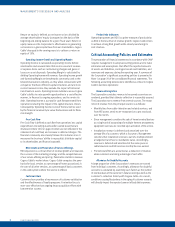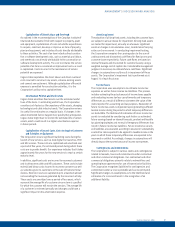Cogeco 2004 Annual Report Download - page 20
Download and view the complete annual report
Please find page 20 of the 2004 Cogeco annual report below. You can navigate through the pages in the report by either clicking on the pages listed below, or by using the keyword search tool below to find specific information within the annual report.
MANAGEMENT’S DISCUSSION AND ANALYSIS
18 Cogeco Cable Inc. 2004
CASH FLOW ANALYSIS
Years ended August 31, 2004 2003
(in thousands of dollars)
(restated)
$$
Operating Activities
Cash flow from operations 144,778 112,525
Net changes in non-cash
working capital items
and long-term deferred
and prepaid income 4,302 19,632
149,080 132,157
Investing Activities
(1)
(98,602) (109,344)
Financing Activities (50,478) (22,813)
(1)
Excludes assets acquired under capital leases.
Operating Activities
Cash flow from operations was greater than last year by
$32.3 million or 28.7%, mainly due to the growth in Operating
Income. The impact of changes in non-cash working capital items
and long-term deferred and prepaid income amounted to a cash
inflow of $4.3 million in fiscal 2004, compared to a cash inflow of
$19.6 million in fiscal 2003. The lower cash inflow from working
capital items and long-term deferred and prepaid income is mainly
related to a slight decline in accounts payable and accrued
liabilities in fiscal 2004 compared to an increase of $11.8 million
in fiscal 2003. On a per share basis, cash flow from operations
increased from $2.82 in fiscal 2003 to $3.63 in fiscal 2004, mainly
as a result of improved Operating Income.
Investing Activities
Investing activities related to capital expenditures and deferred
charges decreased from $110.1 million in fiscal 2003 to
$101.2 million in fiscal 2004. Of these amounts, assets acquired
under capital leases amounted to $2.6 million in fiscal 2004 and
$0.7 million in fiscal 2003.
Capital Expenditures
Capital expenditures, segmented according to the National Cable
Television Association (NCTA) standard reporting categories, are
as follows:
Years ended August 31, 2005 2004 2003
(in thousands of dollars) Guidelines
(1)
(restated)
$$$
Customer premise
equipment
(2)
28,200 27,988 20,201
Scalable infrastructure
(3)
16,400 16,415 25,158
Line extensions 13,300 10,157 9,660
Upgrade/rebuild 36,500 20,893 27,121
Support capital 7,300 5,769 5,883
Total capital
expenditures
(4)
101,700 81,222 88,023
(1)
See “Fiscal 2005 Financial Guidelines” section on page 24 for
further discussion.
(2)
Includes mainly new and replacement drops but also digital terminals,
cable modems and multimedia terminal adapters for telephony.
(3)
Includes headend equipment and most expenditures related to telephony.
(4)
Includes capital leases that are excluded in the statements of cash flow.
In fiscal 2004, the variances related to capital expenditures are
mainly attributable to the following factors:
•
Capital expenditures related to scalable infrastructure declined
due to the initial investment of $7.7 million incurred in fiscal
2003 to introduce VOD.
•
The network upgrade program was reduced during fiscal 2004,
since management intended to test low-cost digital terminals in
an all-digital conversion scenario. Despite reduced investments
in the upgrade program, customer growth has been generally
stronger in fiscal 2004. During fiscal 2005, management will
continue to evaluate all-digital conversion scenarios since doing
so may optimize the use of bandwidth in a more cost-effective
manner. In conducting these evaluations, consideration will
be given to low-cost digital terminals, other techniques and
customer reaction. Pending a satisfactory conclusion to this
analysis, management will resume, during fiscal 2005, its
upgrade program without impairing its projected Free Cash
Flow growth trend.
•
The increase in customer premise equipment mainly results
from a rise in expenditures related to digital terminals. The
number of digital terminals rented to customers increased
as a result of an attractive rental plan launched during the
fourth quarter and a greater number of terminals purchased
at year-end.
























